 How I loved the Harry Potter books! I read them, then I read them aloud to my kids; I even read them a third time as the kids became old enough to read them for themselves. I loved the magic and the way their complexity increased as the original audience grew older along with the novels.
How I loved the Harry Potter books! I read them, then I read them aloud to my kids; I even read them a third time as the kids became old enough to read them for themselves. I loved the magic and the way their complexity increased as the original audience grew older along with the novels.
Years later, I started reading ‘The Casual Vacancy’. When I temporarily mislaid my borrowed copy (it was under the dog bed for several weeks) I never went back to finishing it, which is unusual for me. But I love the world of Troubled Blood! The plot is excellent; the characters complex and I now intend to read the whole series, if in completely the wrong order.
I’ve read several ‘reviews’ of JK Rowling (aka Robert Galbraith)’s latest novel, but very few have been written by people who have actually read it. So here’s mine. For those who haven’t read Troubled Blood yet, I’ll attempt to make it mostly ‘spoiler free’ so as not to diminish your pleasure. I will quite definitely not be revealing whodunnit. And I’ll probably be waffling quite a lot before I get there.
A bit of background
 Hack Jake Kerridge- who had at least read the novel- wrote a pre-release review in the Telegraph on September 13th alluding to ‘a sub-plot to make Rowling’s critics fume’, explaining that the murdered woman, Margot Bamborough, may be ‘a victim of Dennis Creed, a transvestite serial killer’.
Hack Jake Kerridge- who had at least read the novel- wrote a pre-release review in the Telegraph on September 13th alluding to ‘a sub-plot to make Rowling’s critics fume’, explaining that the murdered woman, Margot Bamborough, may be ‘a victim of Dennis Creed, a transvestite serial killer’.
In reportage both more sensationalist than accurate and more suited to The Sun than The Telegraph (Jake seems not to know what the phrase ‘sub-plot’ actually means) he erroneously concluded that the novel was “a book whose moral seems to be: never trust a man in a dress”.
And, oh my giddy aunt, as my old gran would have said, the explosion of fury was heard way beyond the bounds of the Twittersphere.
“No longer satisfied with simply repeatedly expressing her transphobic opinions on Twitter… JK Rowling now appears to be bringing her TERF logic to a bookshelf near you,” bemoaned Emily Kirkpatrick in Vanity Fair on 14th September, going on to helpfully explain, “transvestite is considered an outdated and derogatory term for cross-dressing, which is not the same as being trans.”
Emily does not explain further. Why? Well, she hadn’t read it for a start.
And wait… what? At what point did it become unacceptable for a novel to feature a cross-dressing villain? Nothing is said in Troubled Blood about anybody being ‘trans’, so how is the book transphobic? One young Twitter user attempts to explain.
“i just watched a youtube that was a deep dive into j.k. rowling’s new book… this book is transphobic and offensive… to all those saying ‘you haven’t read the book’ of course not… it’s coded bigotry. It’s baiting you without saying slurs”
So there you have it. It’s transphobic because… er… it’s not.

Scores of horrified tweets and reviews sprung up in the few days after the books release. The book wasn’t released until 15th September and at 927 pages it’s far from an afternoon’s reading. Those incensed by the novel seemed to share one thing in common. They hadn’t read it. Many were incensed at the suggestion that they should read it. Well, nine hundred pages? That’s a long time away from social media.
The day after Troubled Blood hit the shelves, Pink News claimed to have read it. This left me pretty astonished TBH, as I’ve always imagined it would take a Pink News journo about a week to wade through his copy of The Beano.
“Yes, it’s just as problematic as it sounds,’ promised PN. “Troubled Blood serial killer preys on women, masturbates into stolen underwear.”
“The book also references an occasion on which Creed ‘donned the coat of a female co-worker to imitate singer Kay Starr,’ continues PN ominously. Wait… what? This is problematic how exactly?
I ask again, when did it become unacceptable for a story to feature a cross-dressing villain? In 2016 Laverne Cox played transvestite murderer Frankenfurter on stage in the Rocky Horror Picture Show. Confusing? Somewhat. Transphobic? Hardly. There are references to cross-dressing murderers in just a few famous films and books: Psycho (1960), Dressed to Kill (1980) and Silence of the Lambs (1991) spring to mind, but really such fictional characters are far and few between. Some might say ‘times have changed’ but a quick Google informed me that Andrew Lucus’s novel Cross Dressed to Kill was published as recently as 2011. No fuss appears to have been made: in fact, not one of the 55 reviews on goodreads even mentions transphobia and and Mr Lucus’s modest reputation as an author remains untarnished.
Yet torturer and serial killer’s Dennis Creeedy’s penchant for cross dressing in Rowling’s novel has whipped up a storm of fury and a tsunami of accusations of transphobia. Not since The Satanic Verses has such a frenzy been reached over a pivotal but essentially minor character in a novel.
“It’s not the first time she’s done it, you know.”
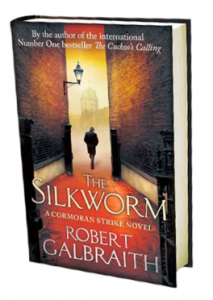 With the revelations about the character of Dennis Creedy, media attention was quickly diverted to the character of Pippa, who features in an earlier book in the ‘Strike’ series: The Silkworm. Whereas Creed is a cross-dressing serial killer, Pippa identifies as transgender. So before we get to Troubled Blood, we’re going to take a quick detour into that chrysalis, which has been cited as further evidence of Rowling’s ‘transphobia’.
With the revelations about the character of Dennis Creedy, media attention was quickly diverted to the character of Pippa, who features in an earlier book in the ‘Strike’ series: The Silkworm. Whereas Creed is a cross-dressing serial killer, Pippa identifies as transgender. So before we get to Troubled Blood, we’re going to take a quick detour into that chrysalis, which has been cited as further evidence of Rowling’s ‘transphobia’.
The Silkworm
“There might be nothing she’s written more vindictive and grotesque–and revealing–than 2014’s The Silkworm,” wrote Rob Zacney in Vice, his article bearing a trigger warning.
The Silkworm, published in 2014, features Pippa, a young transgender person and murder suspect, who attempts to stab Strike. Strangely, Pippa’s appearance in The Silkworm did not seem to raise problems with TRAs until after Rowling’s infamous, ‘Wumben? Wimpund? Woomud?‘ tweet. In the last few weeks, many righteously angry references to the novel have been made online, but always quoting just one speech, the one where Strike tells Pippa:
“If you go for that door one more time I’m calling the police and I’ll testify and be glad to watch you go down for attempted murder. And it won’t be fun for you Pippa. Not pre-op.”
Now I can’t review The Silkworm for one obvious reason. I haven’t read all of it (I’m still halfway through the prequel The Cuckoo’s Calling). But I did want to see the context for myself. So I contacted Charlotte- the only person I know who actually did pile through Troubled Blood in a day. Sure enough, Charlotte had read The Silkworm and was happy to send me over photos of the pages involving Pippa, and a bit of backstory which I won’t share here as you might want to read the series yourself.
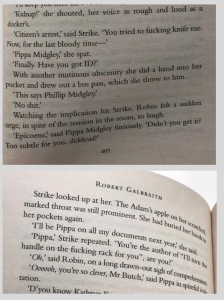 I read through the dozen pages Charlotte had sent me and this is what I found. Pippa is about twenty, with “a long pale face with large brown eyes and thick dark wavy hair that fell to her shoulders”and “pointed crimson nails”.
I read through the dozen pages Charlotte had sent me and this is what I found. Pippa is about twenty, with “a long pale face with large brown eyes and thick dark wavy hair that fell to her shoulders”and “pointed crimson nails”.
“‘She just tried to bloody knife me again!” Strike tells an astonished Robin as he pushes Pippa into the agency office for questioning. When an angry Pippa is persuaded to hand over some ID, it bears the name Phillip Midgley. Neither Strike not Robin are unkind about the turn of events, nor do they seem especially shocked. Robin’s response is to offer Pippa some coffee, causing an irate Strike to point out again, “She’s just tried to bloody knife me, Robin!”
Note his unaffected use of ‘she’. Coffee is procured and we are told, “unstable and aggressive though Pippa seemed, Robin could not help pitying the girl…”
The girl.
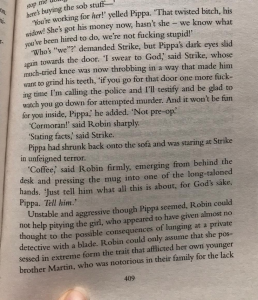 When Strike makes his “if you go for that door one more time…” comment- let’s remember, Pippa has just tried to stab him- Robin reprimands him sharply. (see right)
When Strike makes his “if you go for that door one more time…” comment- let’s remember, Pippa has just tried to stab him- Robin reprimands him sharply. (see right)
After Pippa escapes, the police are not called and there are no unkind jokes made. Not even ‘misgendering’. Robin’s final comment is “I really did feel a bit sorry for her.”
That’s it.
Troubled Blood – rabid reviews

Official sales figures show that Troubled Blood burst on the scene to hit the No 1 spot in the UK’s book charts, despite the drama and accusations, selling 64,633 copies in the five days to 19 September.
“JK Rowling’s new thriller takes No 1 spot amid transphobia row!” wrote Alison Flood in the Guardian.
Number one in the fiction hardback chart, the novel was also the bestselling title across any genre or format, as well as receiving 4.8 out of 5 stars on Amazon. Yet to look at the reviews in the mainstream press, one might be forgiven for thinking otherwise.
“JK Rowling’s new book Troubled Blood hits no 1 in charts despite transphobia accusations” trilled Emma Kelly in the METRO.
“Yep, J.K. Rowling’s new thriller has transphobic elements. It’s also a crashing bore” responded Bethanne Patrick in the LA Times.
““I can’t imagine going back and explaining to my teenage self, ‘Hey, this author you love so much blatantly hates people like you.” cried Marieke Nijkamp in TIME magazine.
“It’s impossible not to feel hate in her own words, both online and in print.” warned Kelly Lawler in USA Today.
Cross-dressing killers
Yes, the book does feature a serial killer of the most vicious and sadistic kind, who tortures his female victims before killing them. He is indeed reported to have masturbated into women’s underwear, although of all his weaknesses that strikes me as perhaps the most trivial. He also disguises himself as a woman to disarm his victims, and hoards their jewellery after he has killed them.
The first mention of Creed is on pages 75 and 82. We learn that he attempted to abduct one victim while, ‘dressed as a woman at a lonely bus stop… ‘wearing a wig… and all padded out in a woman’s coat’. Strike connects this with the disappearance of another woman who was ‘seen getting into a van with what appeared to be another woman’.
‘Dennis Creed sometimes cross-dressed,’ observes one character during interview.
“You know his explanation for having a stash of jewellery under the floorboards?” the father of a murdered girl asks Robin. “That he’d bought it to dress up in.”
“A genius of misdirection,” reflects Robin, of Creed, “in his little white van, dressed in the pink coat he’d stolen from Vi Cooper, and sometimes wearing a wig that, from a distance, to a drunk victim, gave his hazy form a feminine appearance just long enough for his large hands to close over a gasping mouth.”
It should be made clear that nowhere is it suggested that Creed thinks of himself as a woman or uses female pronouns.
On Galbraith’s website, Rowling writes that the character of Creed was “loosely based on real-life killers Jerry Brudos and Russell Williams – both master manipulators who took trophies from their victims”.
Brudos is mentioned in Troubled Blood. In a conversation between Robin and Max we are told: ‘Like Creed, Brudos had been wearing women’s clothing when he abducted one of his victims.’
I had heard of neither Brudos nor Williams. Googling their names, I was drawn into a labyrinth of references to some of the darkest crimes men commit against women.
Skipping from page to page, link to link, I learned that since the 1960s, IRL transvestite murderers have included the following men:
Jerome Brudos, Jefferey Gorton, Roderick Deakin-White, Ottis Toole, Doil Lane, Hadden Irving Clark, Alan Hawe, Colin Coates, Russell Williams, Gary Heidnik, Richard Sharpe, Dennis Rader, Edmond Tennent Brown, Robin Pask, James Allen and Reginald Arthurell.
This is neither a chronological nor an exhaustive list, but it certainly shows that the cross-dressing killer is not a figment of Rowling’s imagination- and nor is the horrific fate the fictional Margot Bamborough shared with hundreds of real women.
To suggest that acknowledging this is tantamount to claiming that all cross-dressers are mass murderers is absurd. To claim ‘this never happens’ is equally absurd. To suggest that creating one such man in a work of fiction is tantamount to expressing hatred for trans-identified people is, well, completely fucking bonkers.
It almost seems as if we are living in a culture where women writing about the men who commit these acts is considered to be more offensive than the acts themselves.
The Review, at last
Troubled Blood is indeed a tome, stretching to 927 pages: so heavy in fact that at one point, while I was reading it lying in a hammock, one side slipped from my fingers and the weight tore out a page.
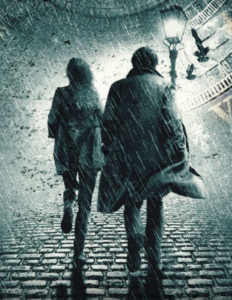 Troubled Blood caught me from the outset. Even the cover art is full of promise, as is often the way with glossy hardbacks. The two, blue-grey, trenchcoated detectives move purposefully along a wet cobbled street, poised to magically enter the heart of the Hampton Court Palace Astrological Clock.
Troubled Blood caught me from the outset. Even the cover art is full of promise, as is often the way with glossy hardbacks. The two, blue-grey, trenchcoated detectives move purposefully along a wet cobbled street, poised to magically enter the heart of the Hampton Court Palace Astrological Clock.
It is easy to imagine the novel as a film or TV series, I mused as I read; it would transfer almost seamlessly to the screen. In my head I cast Chloe Decker (Lauren German) from Lucifer as the waif-like yet steel-cored Robin. Strike, the macho hero with a sensitive streak, reminded me of a more refined and less volatile version of Gene Hunt (Philip Glenister) in Ashes to Ashes.
When I started research for this review I discovered – late to the party as I so often am- that the first four books have already been made into a TV series, starring Holliday Grainger and Tom Burke.
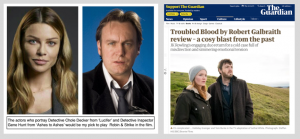
Casting: left: my choice, right: Shaheen Baig’s choice
In an interesting coincidence, Philip Glenister, my choice for Strike, is younger brother to Robert who voices the audio books and plays Jasper Chiswell in the TV adaptation of Lethal White, the 4th of the Strike novels.
Charlotte tells me that the character of Pippa was cut from the TV version of The Silkworm.
Brits, you can currently watch the first three series for free here on BBC iPlayer.
Back to Troubled Blood.
Robin & Strike
Strike broods a lot, doesn’t talk about his emotions and survives primarily on pot noodles, out of date leftovers and cigarettes. Strike had an unsettled childhood, raised by his hippy, often absent mother. As an adult, he saw horrors in war and his lower leg was blown off in Afghanistan. Single since his break up from the beautiful but crazy Charlotte, but not averse to the odd one night stand, he’s aware of his appeal to women despite it being made clear that he’s not a traditionally good looking bloke. Women are an enigma to him: as he wanders through a department store, trying to choose a present for Robin he observes, “endless processions of women kept ranging across his path, choosing items with apparent effortless ease. Were they genetically programmed to seek and find the right gift?”
Robin fits what I call the ‘you don’t know you’re beautiful’ class of heroine, pale with strawberry blonde hair, watching her weight even though she clearly has no need to; chaste since her break up with her cheating and controlling husband Matt and dwelling occasionally on her biological clock.
Stereotypes? Well yes, but also no.
Robin may be insecure but she’s clever, independent and sometimes fierce. Nobody is keeping her down. She is a survivor of a particularly horrible rape yet remains altruistic and positive about human nature, while always conscious of the male desire for domination or mastery over others. On observing two men shaking hands after one such power-play, ‘Robin wondered how aware men were of the power dynamics that played out between them, while women stood watching.’
 Later we are told that Robin is comfortable with Strike because while he is bigger than her he had never made her feel it, “as so many men did, not in an attempt to intimidate but because they enjoy the Parade, as a peacock spreads its tail.”
Later we are told that Robin is comfortable with Strike because while he is bigger than her he had never made her feel it, “as so many men did, not in an attempt to intimidate but because they enjoy the Parade, as a peacock spreads its tail.”
When a co-worker texts her a picture of his erect penis, Robin, shocked and horrified, calls and angrily challenges him. As he sobs drunken apologies down the phone and begs her not to tell anyone, ‘his gushing offended her almost as much as the picture of his dick.’
It’s clear that all he’s really concerned about is his boss and ex-wife finding out what he’s done and the possibility of losing his job and access to his kids. Robin is put in mind of her cheating ex-husband and wonders, ‘What was it about her that made men demand she kept their dirty secrets?’
Both Robin and Strike are childless and solitary individuals with broken long-term relationships. Both have trouble escaping their controlling exes, building relationships and building bridges. Both wrestle with the violence and damage in their pasts. Underlying their competence, commitment and fortitude lies inferred, but unspoken, PTSD.
I wasn’t hugely drawn in by the ‘will they, won’t they’ aspect of their relationship, perhaps the sexual tension was just too subtle for my taste. Rowling has made it clear that she enjoys writing the Strike novels too much to stop any time soon. So if they ‘do’, there might be quite a wait.
Rowling really does pull off the characterisation of the protagonists. They are complex, flawed but both deeply likeable. In contrast, minor characters are usually obnoxious, rarely likeable, sometimes even verging on caricatures. This is a tactic that works well and keeps the reader’s focus on the protagonists.

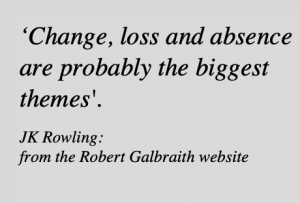
Margot’s daughter Anna, who employs Strike and Robin to find out what happened to her mother, lives with her psychologist partner Kim and their cats, Cagney and Lacey. Kim is protective of Anna, who is described as having “large grey eyes… an air of intensity, even of fanaticism, like a medieval martyr.”
Anna is one of the more likeable characters. The path of her life has been blighted by nightmares and driven by the disappearance of her mother and she wants Strike to help her discover the truth. Like many other characters, Anna is irreversibly damaged by the loss in her life.
Rowling has been accused of virtue signalling by some reviewers for making Anna a lesbian- probably the same reviewers who have berated her for not including gay and lesbian characters in other novels.
One of the more likeable men in the novel is also gay. Max is Robin’s live-in landlord. ‘Ruggedly handsome, tall and broad shouldered, with a full head of thick, dark blonde hair’, Max is an actor, often gloomy, still brooding over his own loss, the break-up with his partner who left him with the too-big house which he now shares with Robin.

Robin meets in a café with Tucker, whose daughter Louise went missing in 1972. Tucker, whose eyes are ‘small, flecked and almost colourless’ is convinced Louise was killed by Creed. ‘Utterly consumed’ by his lifelong quest for justice, he tell Robin, ‘this has been my whole life”.
“It’s affected our whole family,” his granddaughter Lauren tells Robin. “Mum and Aunty Lisa are always scared if me and my cousins go out after dark- and all of us grew up knowing that it’s something that can really happen, you know?”
The absence of the missing women creates a ripple effect which spreads throughout the novel.
Woven through the story is the journey towards death from cancer of the aunt, ‘provider and nurturer’ who raised Strike. Rowling deals with this delicately, drawing out a gentler side of Strike and embracing the pathos, futility and inevitability of death. Joan’s long life and slow but peaceful end stands in contrast to the short lives and violent deaths of the murder victims.
Feminism
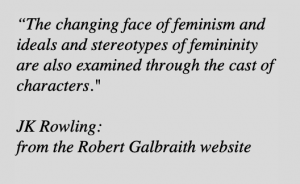
‘What you maybe don’t realise,” Oonagh Kennedy, who was a bunny girl with Margot back in the 70s, tells Strike, “is a woman couldn’t get a mortgage in those days without a man co-signing the forms. Same with credit cards… Middle class gorls, with their mammies and daddies paying their way, they could afford to burn their bras and have hairy armpits. Margot and I, we did what we had to.”
Later the same woman observes, “I spent ten years working with domestic abuse survivors in Wolverhampton and it’s one of the hallmarks of an abuser. If their victim isn’t compliant she’s under someone else’s control… he stepped right up to me, the way a man will if he wants to remind you what he could do if he wanted.“
Misogyny & violence
“I’ve always been clever, but that don’t help a woman,” Janice Beattie tells Robin. “It’s better to be pretty.”
There are some startlingly dark moments in the novel, which many women may find deeply disturbing: a ‘snuff movie’ where a woman is raped and stabbed to death by a group of men; some graphic descriptions of the violence inflicted by Creed on his victims. When Robin is reading a salacious book about the murders, she skips over some pages dealing with torture and their content is left to the imagination. These moments are often made darker by the suggestion that so much more is left unsaid.
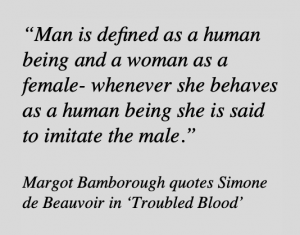 Casual misogyny cascades rather than runs through the pages, where the reader’s attention is drawn to it again and again, reminded how much, and yet how little, things have changed for women since the seventies.
Casual misogyny cascades rather than runs through the pages, where the reader’s attention is drawn to it again and again, reminded how much, and yet how little, things have changed for women since the seventies.
The mystery of who did or didn’t have a secret abortion at a London clinic is a thread running through the story, and the subject of abortion is spoken of in hushed tones by many of the women in the book. Abortion had only been legal for five years in 1974 and was still looked on as a dirty secret and something to be ashamed of. To say more about this would need a spoiler alert.
“People are always asking me what it’s like to work with a lady doctor, and if I ever meet one, I’ll tell them,” joked one doctor, back in the 70s, after Bamborough dropped her pen and swore in a meeting.
“(He)was probably the biggest misogynist I’d ever met.” Gloria later tells the detectives. “He’d denigrate women for not looking feminine or talking like a lady… I suppose what he wanted was for us all to be subordinate and respectful, high collars, low hemlines.”
Back in 2013, we meet Oakden, a cheap, unlikeable crook who refers to women as ‘slags’ and has a penchant for swindling older women out of their life savings. He is a parody of a men’s rights activist, describing himself as a life coach and expert in ‘masculism, father’s rights, gynocentism, men’s mental health, female privilege and toxic feminism… cultural misandry and male exploitation.’
“You’ve got the pill,” he scoffs, “…enabling women to avoid or subvert the reproductive function… a gynocentric court system… misandrist authoritarianism… look but don’t touch… male suffering, nobody gives a shit.”
Shortly after talking to him, Robin reflects on how ‘her job reminded her almost daily of the many ways men and women could hurt each other.’
Minutes later, Oakden goads Strike into taking a swing at him. Robin tries to stop him and Strike misses, hitting her hard between the eyes, causing her to bleed profusely. Initially I couldn’t see the point of including this incident, but retrospectively I see it as a simple acknowledgement of just how much physically stronger male bodies are, and how easy it is for men to injure women even when that is not their intent.
Prostitution
At a dinner party, two drunk uni students talk loudly about the societal benefits of prostitution. Irritated beyond belief, drunk himself, Strike can stay silent no longer (below).
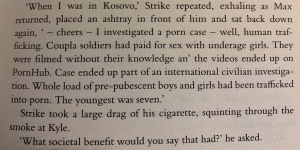
“Porn industry’s full of trafficking,” concludes Strike. “Women and kids from poor countries.”
When the same dinner party conversation turns to ‘Slutwalks’ a drunken Strike dismisses them as “a bunch’f nice middle class girls going for a walk in their underwear… you think rapists’ll see you all marching ‘long and think ‘better jack in the raping’ do you?… The kind of man who calls women sluts’ll look at your fucking sideshow and think ‘there go a load of sluts, look’. You don’t change … real world attitudes by deciding slurs aren’t derogatory.”
Strike and Robin visit one witness, an vindictive and unpleasant woman, an elderly ex-prostitute, who shares the same contempt for the pseudo-liberal attitudes of her social worker.
“Sex work is work,” spits out Betty, between wheezes, “they’ll tell yer that… patronisin’… fuckin’… but would they want.. their daughters… doin’ it? Would they fuck!”
The same woman claims there were fewer prostituted underage girls back then “my day we’d’ve marched ’em… right back ‘ome”.
“Ma, you wouldn’t like it these days,” her own ‘escort’ daughter tells her, “all they want is anal.”
Race
Talbot, the cop who was investigating the murder back in 1974, kept a notebook of his wild astrological meanderings linked to potential suspects. Robin and Strike are discussing his casually racist attitude towards Wilma, who is described in his notebook as ‘black phantom.. . black moon Lilith… armed and militant.’
“A Radical feminist witch,” observes Strike.
“Which sounds quite cool when you say it, said Robin, ‘but I don’t think Talbot meant it that way.’

Tiana Medaini, missing since 2013
When Robin and Strike interview Wilma’s daughters, Eden refers to the real life case of Tiana Medaini, a black teenager from Lewisham who went missing in 2013 and has still not been found.
“Forty years after Margot Bamborough went missing here we all are fussing over her and where she went… how many front pages has Tiana been on? Why wasn’t she top of the news like Bamborough was? Because we’re not worth the same, are we, to the press or the bloody police?”
In conclusion

Of course, I haven’t even begun to touch on many of the characters and incidents in the novel. A thorough analysis would probably end up being longer than the novel itself. Despite my having focused on predominantly feminist aspects, there are so many other things going on that I imagine those elements might seem almost incidental to the casual reader. What a shame that Rowling has dealt with so many important social issues with such depth and sensitivity, yet media attention seems to be focused on accusations of transphobia.
I’m now about a third of the way through ‘The Cuckoo’s Calling’, the first novel in the series, having purchased a second hand, ex-library copy from the UK branch of Better World Books, a business which also raises money for literacy programs by saving old library books and reselling them.
I recommend reading Troubled Blood, but if you’re a fan of decent crime fiction you should probably start at the beginning of the ‘Strike’ series, not at the end!
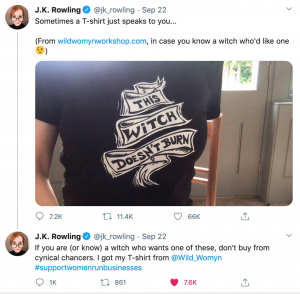
Rowling recently tweeted a picture of herself in a ‘this witch doesn’t burn’ T shirt.
For those of you reading before Thursday 8th October, there is a Facebook event coming up: Robert Galbraith in conversation with Mark Billingham.

I suppose people who have never had to think about serial killers in their neighborhood should be blissfully ignorant. Still, it is disconcerting when something you consider common knowledge sparks outrage among them.
I have read all Rowling’s novels as they were published, and thoroughly enjoyed seeing her skill develop. I still do not like her rushed endings, but she clearly does so I have gotten used to them.
I enjoyed the leisurely pace of ‘a year in the life of partners in a London detective agency’.
Thank you, I am lured into the story by your excellent review, very tempted to add to my reading list .
After having read this (and having just started to read the first of the series, I do want to read in order ha) I think my eyes will be opened to what else JK Rowling has hidden in the sub-text. Thank you Lily – excellent review.